
Tuesday, 10 July 2018
Distance 32 km
Duration 6 hours 50 minutes
Ascent 68 m, descent 80 m
Because of our failure to press on yesterday, we had a long walk in front of us today. We had shortened our route a bit by not going to la Guerche-sur-l’Aubois, but even so it was over thirty kilometres.
That being the case, we decided to put some distance between us and Sancoins before breakfast.

We were under way by 6:30 am and on the canal a minute later, as the first rays of the rising sun tinted the houses across the water.
We had walked this way before, albeit in the opposite direction, as it is on the GR654, the Way of Vézelay.
The first part was a normal towpath walk beside the canal, but after a while the water in the canal disappeared.

Many sections of the Canal de Berry have become dry since it was declassified in 1955.
This section was very overgrown but we could still make out the former bed of the canal, now choked with vegetation, and could appreciate the enormous effort that was put into constructing it.
It was lucky that its builders did not know that it would last scarcely more than a century.
We came out of the forest into a wide grassy swathe (the canal was buried underneath it) and approached the village of Grossouvre, where there was a boulangerie and a bar side by side, the former open and the latter not.

Some workmen nearby said that there was another bar 500 metres along the road, so we got some croissants, by which time the door of the bar had opened.
Inside, it was extremely plain and bare, but we sat down and a bent old lady appeared from the back.
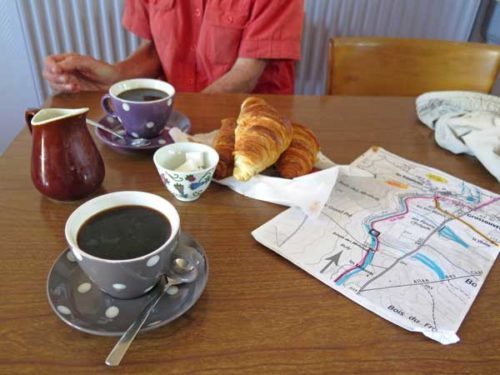
She tottered off to make coffee and when it came it was remarkably good. We then sent her back to heat up the milk, feeling rather guilty.
As we set off again, we remembered the picturesque old factory from our previous visit – a tile factory (une tuilerie, as they say in French).
It was still operating, with piles of crates and boxes all around it.
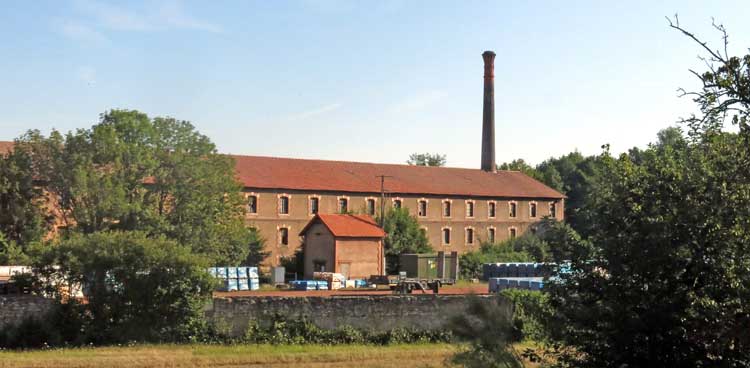
The village itself was a string of well-kept little cottages separated by gardens, with a sweet little grey church on the corner.
At the highway intersection there was a fancy new bar, but we were glad that we had gone to the old-fashioned one in the village.

At this point we deviated from our prepared map, as we were no longer going to la Guerche-sur-l’Aubois.
Instead we followed the GR markings of the Way of Vézelay, past the château, through some fields with white cattle and into the Forest of Apremont, as we had done, in reverse, years ago.

It was bitumen all the way (the D76), and rather monotonous, although shady and pleasant enough.
Towards the end we came to the old line of demarcation between occupied and non-occupied France, imposed by the invading Germans in 1940 and losing its meaning in late 1942 when the whole of France became occupied territory.
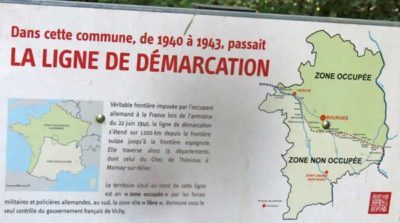
We reached the village of Apremont, on the banks of the Allier, two hours after leaving Grossouvre, and even at that late hour the cafés were only just opening.

It is a Plus Beau Village, with all the pretension and artificiality that goes with that.
Nevertheless it deserves to be recognised for its beauty, especially the row of old mariners’ houses along the river front.
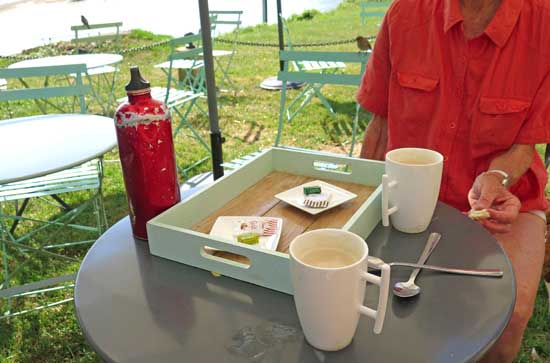
We sat down under a white umbrella on the grassy river bank, and drank our very expensive coffee (€8 for two cups) with appreciation.
At the same time we finished the ham, cheese and bread that we had saved from the magnificent breakfast at le Veurdre.
The Allier here was wide and shallow, lined with willows and streaked by sandbars.
It only had another five kilometres to run before being swallowed up by the Loire, and all that remained for us was to follow it downstream to its end.
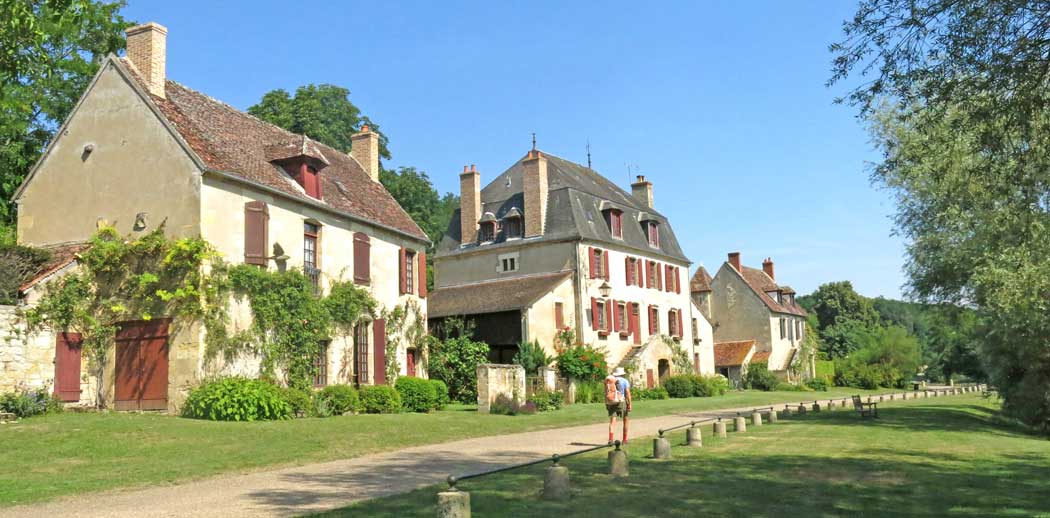
A couple of kilometres along we came to a strange piece of engineering, the circular lock of les Lorrains. It was originally built in 1838 to allow sand barges to move from the river to the Lateral Canal of the Loire, via a short extra canal.
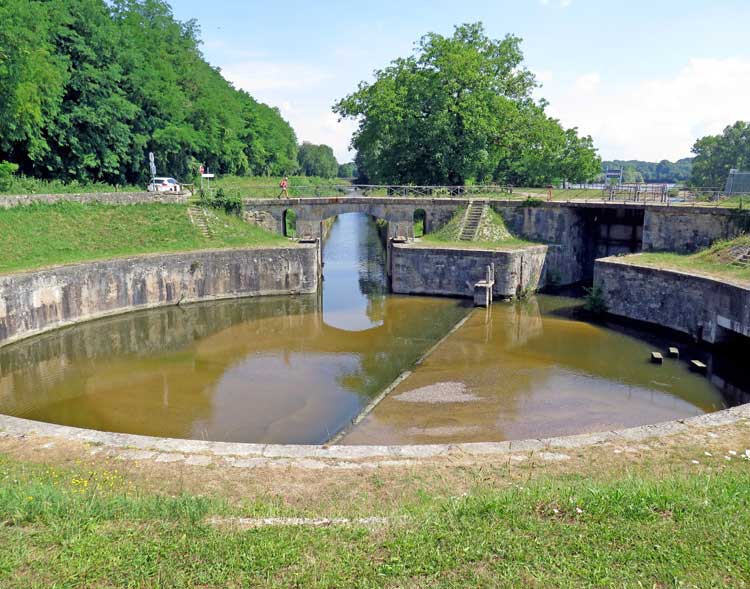
This required a sharp turn on the part of the barges, which is why the lock was circular – horses were used to rotate the boats.
Only a few decades later, the level of the river fell below the lock entrance and it became unusable for boats, but the adjoining canal is still used to feed water from a spring into the Lateral Canal.
Beyond this point we walked on a bitumen cycle path with frequent GR signs, and soon emerged onto a road at Grenouille.
The hotel on the corner was where we had enjoyed an unexpected and very welcome breakfast last time we passed this way, coming from the north.

However this time when we stepped in, the place seemed dark and gloomy, with one old drunkard the only occupant.
Before any waiter appeared, we slipped out, turned away from the alimentation canal and continued another kilometre until we came to the Lateral Canal of the Loire, which was about to cross the last part of the Allier on a pont-canal.
As we had hoped, there was a grand old auberge there, full of people having lunch on the balcony at the back, which had a lovely view onto the trees beside the canal.
As mere coffee-drinkers we had to sit in the less salubrious front section beside the bar, where we surreptitiously ate the left-over steak, vegetables and bread from last night’s dinner.

The pont-canal was high and very long, crossing the Allier only a few hundred metres from its junction with the Loire, the so-called Bec d’Allier.
On the other side we passed through a slumbering village, crossed the highway (the D976) and followed a track into an unruly mass of trees bordering the Loire.
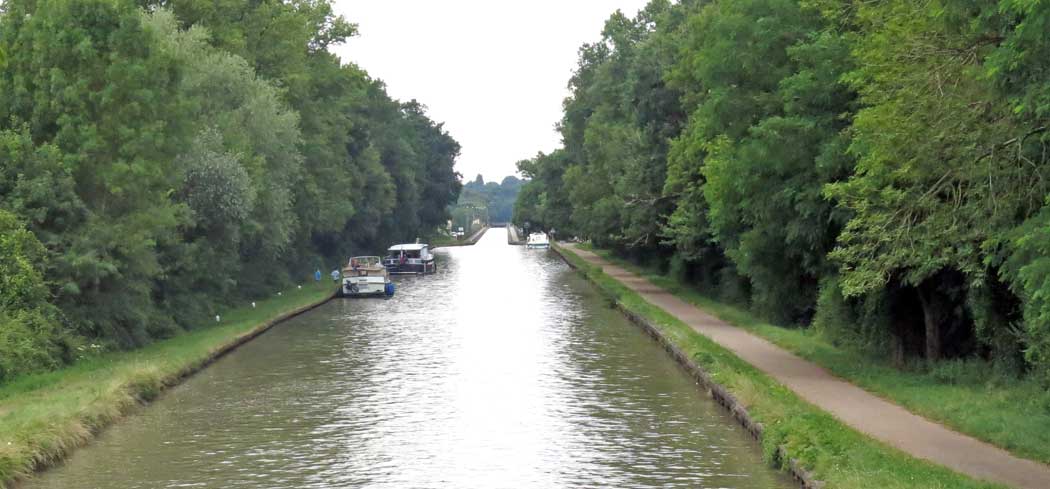
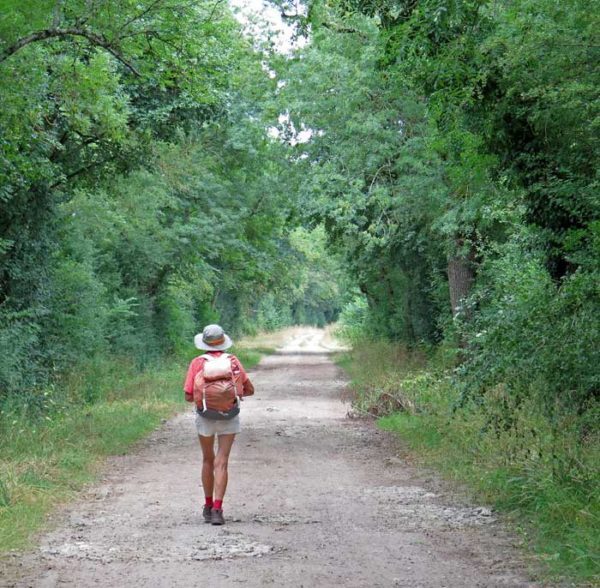
There was no danger of getting lost, as we were still on the Way of Vézelay.
The surprising thing was that so far we had seen no pilgrims coming the other way, unless you counted a couple of laden cyclists pushing their bikes over the pont-canal.
Half-way along this track, we did meet a walker, a solitary man wearing a big pack and a cockle-shell, who muttered a dour greeting and kept going. Such is often the way with lone pilgrims.
We walked on this track in the heat of the afternoon for more than an hour before we arrived at the first signs of the town of Nevers, and soon afterwards we were in the streets.
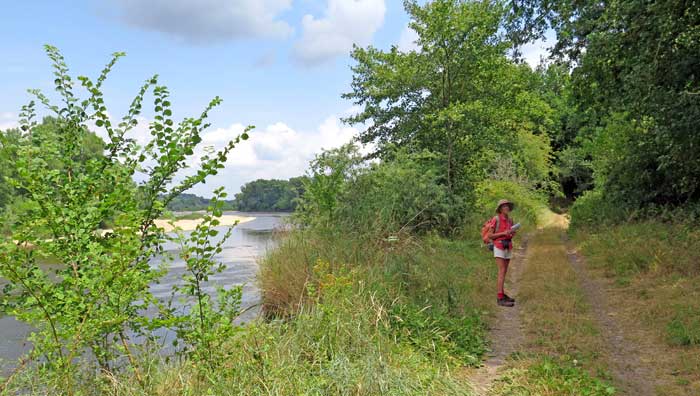
Having camped here before (on a train trip), we knew that the camping ground was right next to the bridge, but we had not previously seen the Hotel Ibis across the road – perhaps it was not there at the time. It looked a good place for a dinner.
At the camping ground, large campervans occupied the upper terraces, while smaller vehicles, cyclists and walkers were sent to the grassy area below.
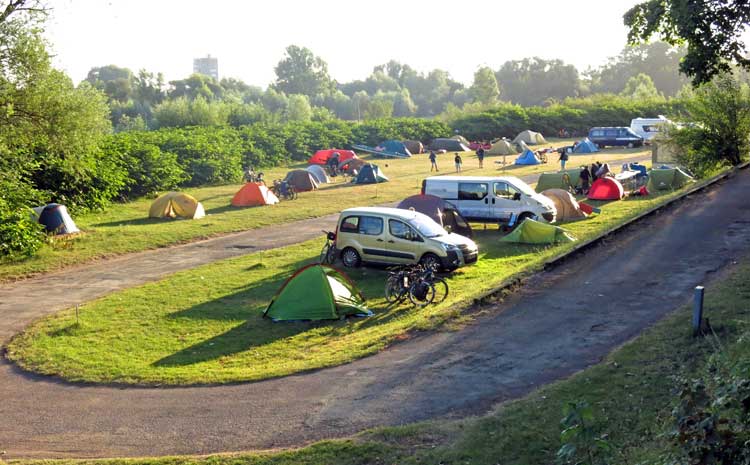
Having paid our dues (€12.34), we asked about the possibility of seeing “le Match” tonight – the semi-final between France and Belgium, to which the answer was a resounding yes.
On the grass there was a multitude of small tents, inhabited by cyclists or school groups, and it was a pleasant change not to be the only small tent in the place, although we did seem to be the only walkers.
As I returned from the showers a woman was reclining in full sun beside a British car, and I commiserated about the sweltering weather. “Yes, isn’t it lovely?”, she beamed.

At about 7 pm we stepped across the highway to the Ibis hotel and took our obligatory rosé on the terrace.
Everything looked raw and new and slightly vulgar, but it was pleasant enough, and surprisingly quiet considering that it was only a few metres from the main road.
For dinner we moved indoors, as the air was cooling down fast. There was the usual sprinkling of single male diners, plus a few others in the room.
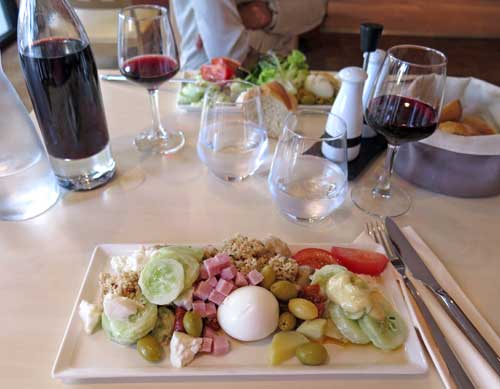
The menu was simple but good – two courses for €17. We began with a buffet of crudités, where we filled our plates greedily as usual, and that was delicious.
Then Keith had three lamb chops with sautéed potatoes, which he pronounced excellent, while I had dorade (bream) with ratatouille, also very good.

Back at the camping ground, it was half-time in le Match, and we wriggled into some seats in the TV room, which was packed.
The score was 0-0. When France scored the only goal of the match, the room erupted in joy and the school kids even did a little dance. We all went to bed happy, except perhaps for any Belgians in the place.